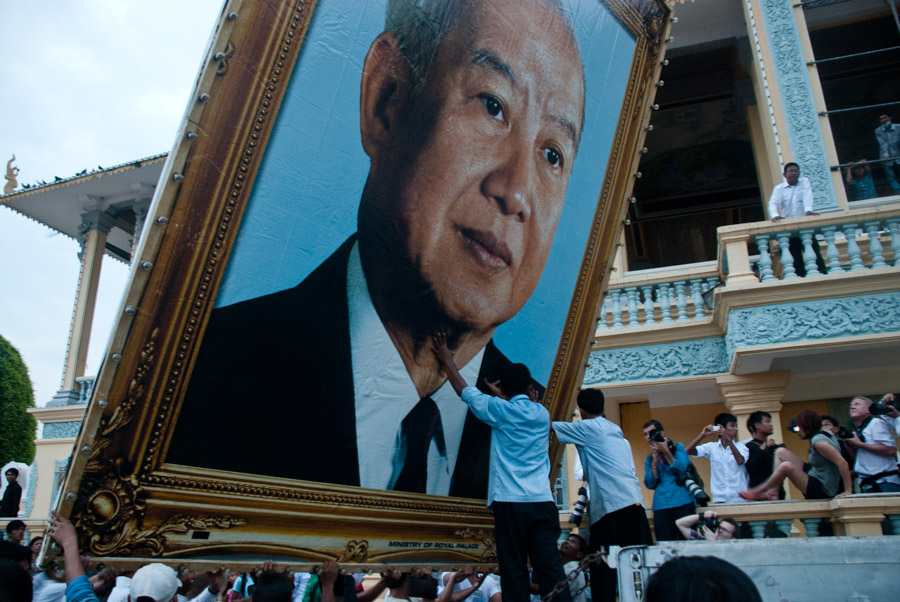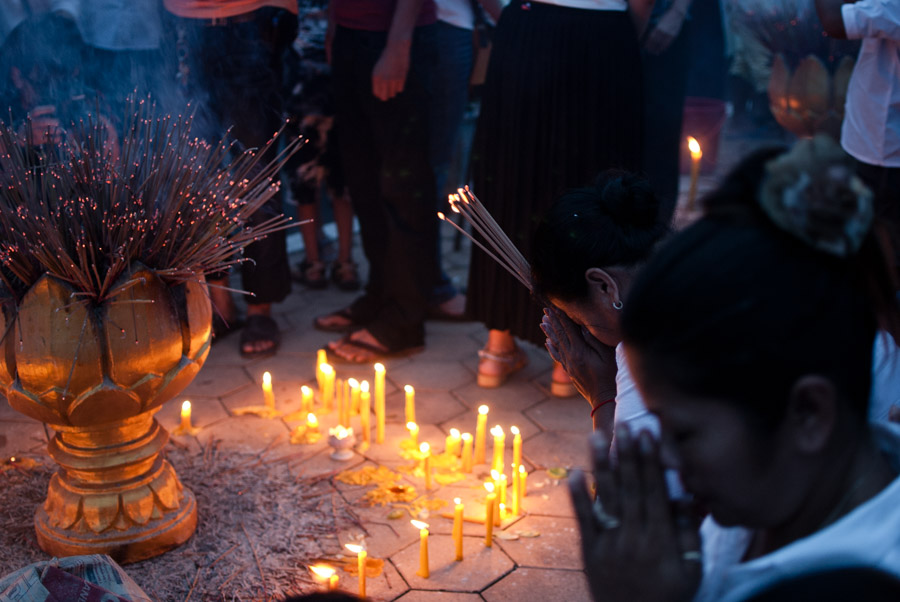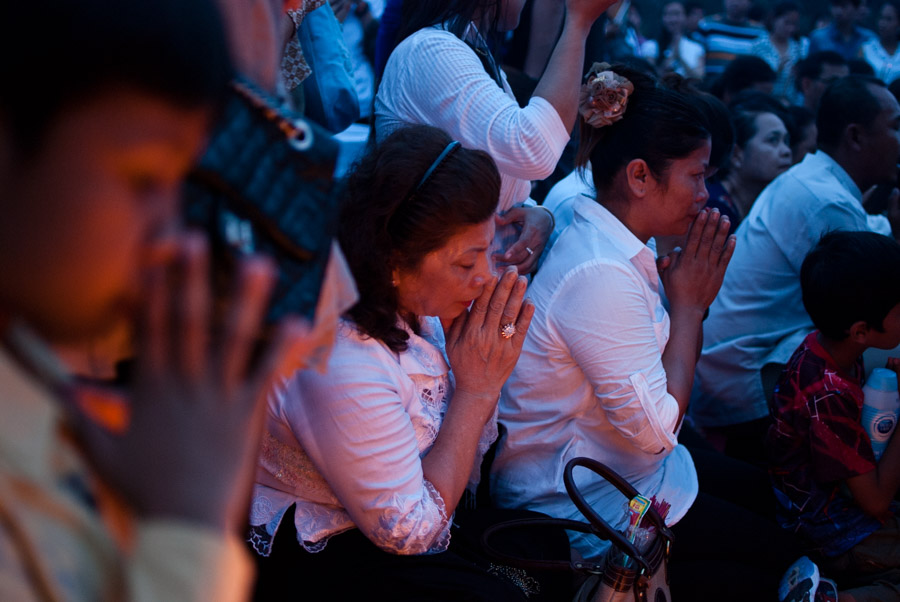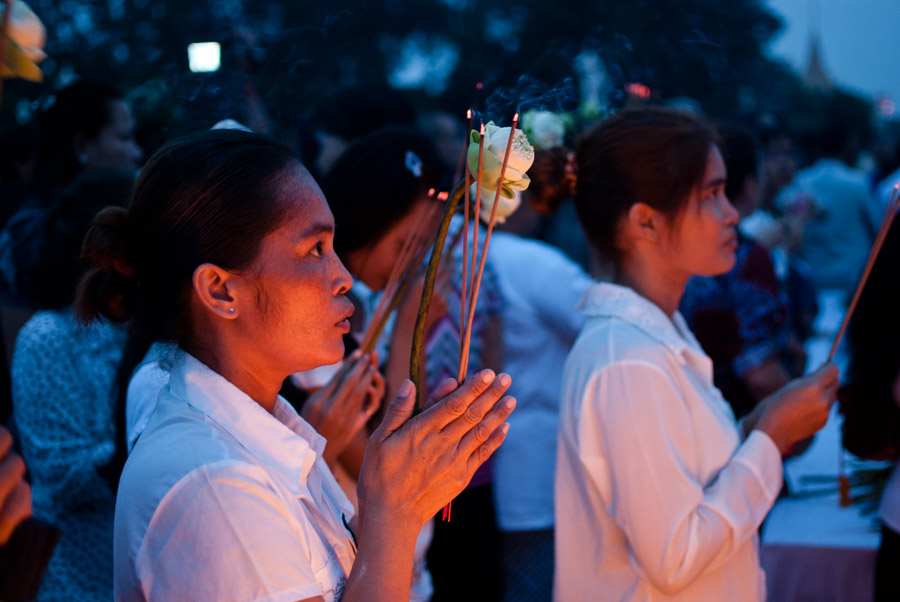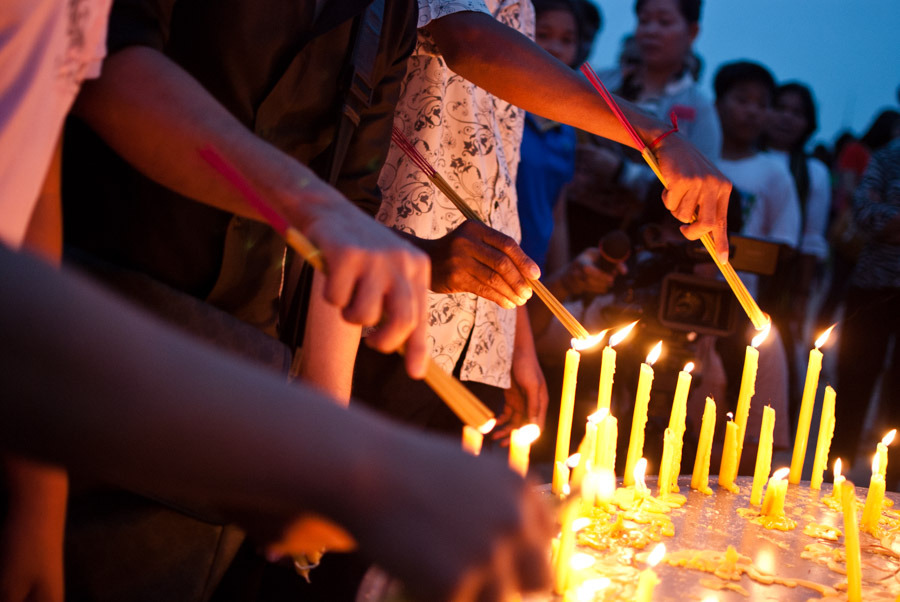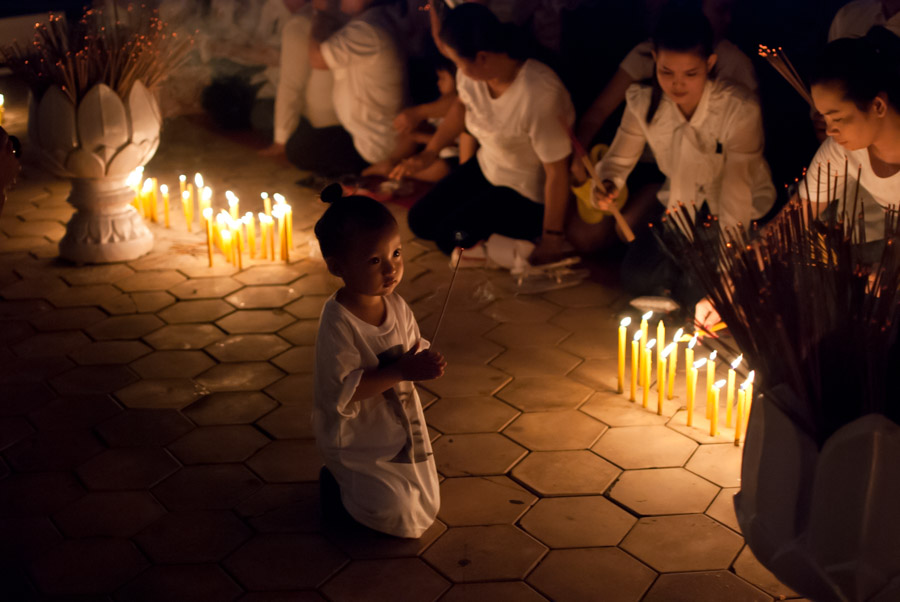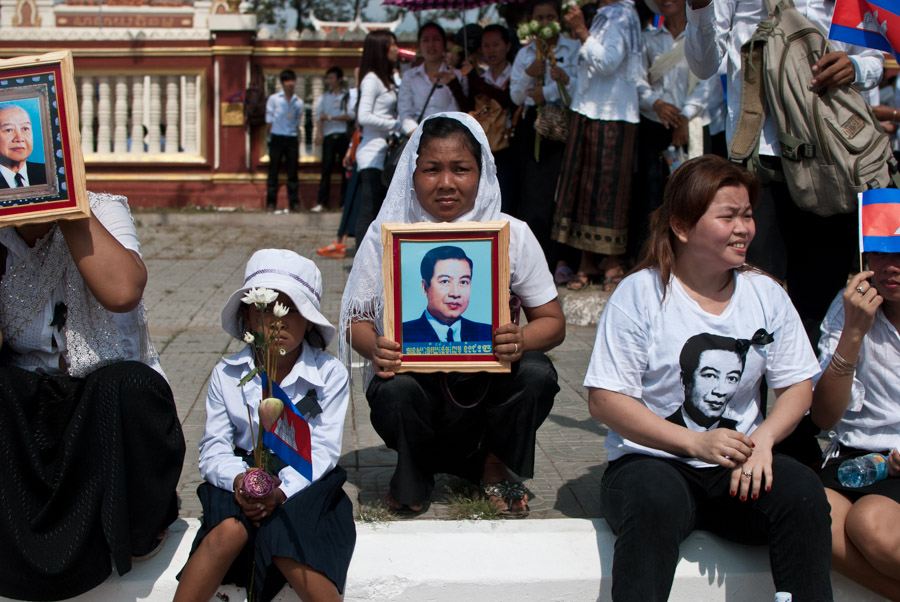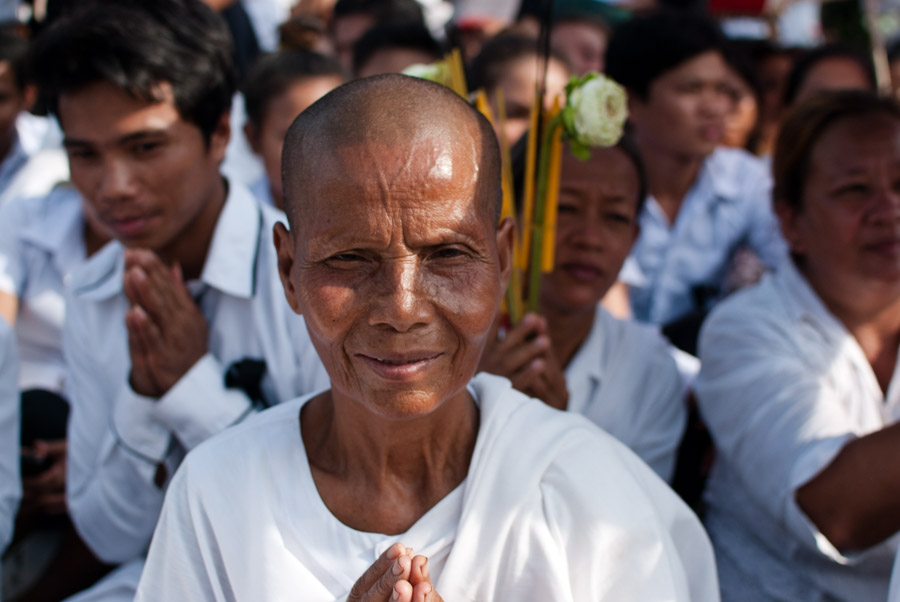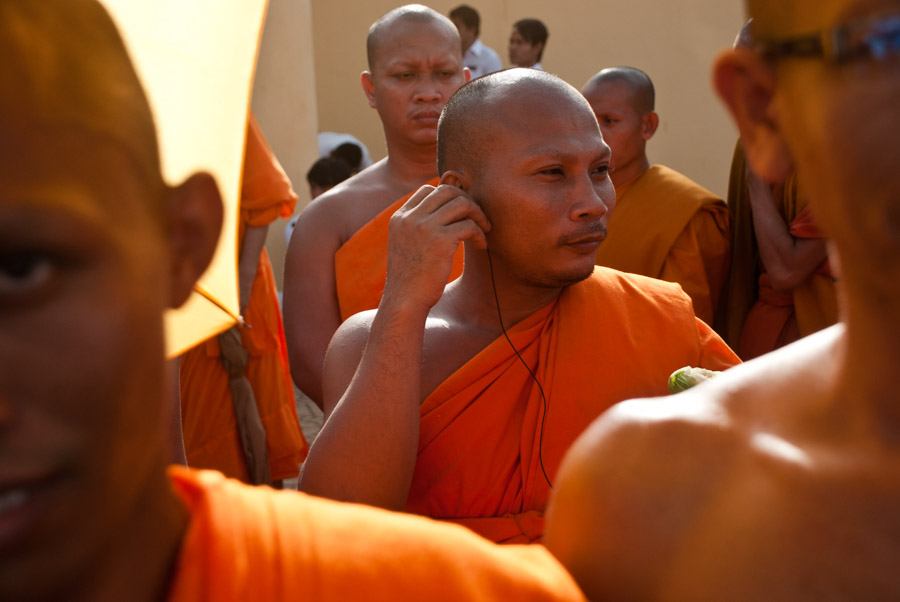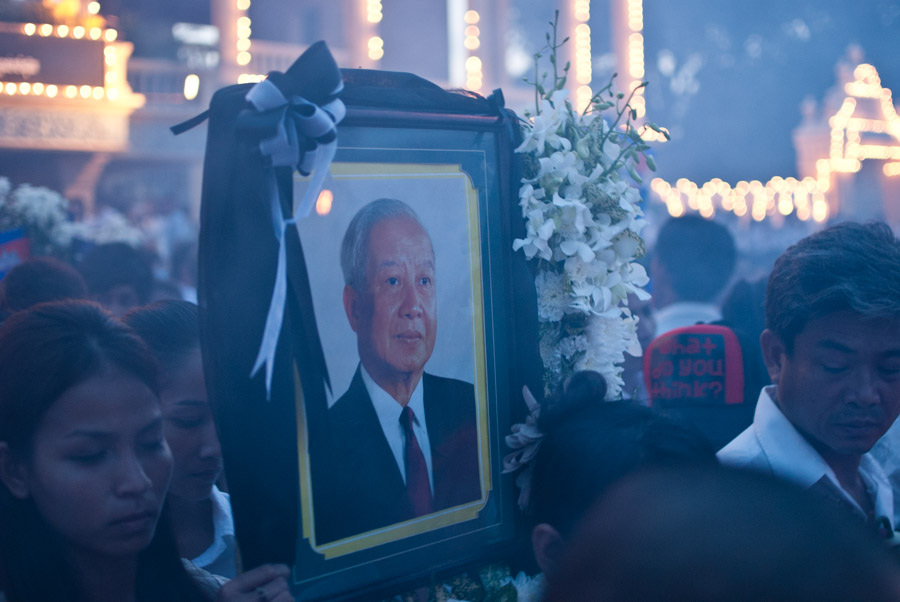Cambodia’s singular, eccentric leader comes home to rest.
PHNOM PENH — On Wednesday, Norodom Sihanouk made his final, memorable return to Cambodia. The revered monarch died of a heart attack in Beijing on October 15, and Cambodians came out in their tens of thousands as his gold funeral carriage arrived from China and made its way slowly through the capital. Most were dressed in white, clutching lotus flowers, candles and portraits of the beloved “King Father,” who would have turned 90 on October 31. Some wept openly as the coffin — festooned with flowers and draped with the kingdom’s royal blue standard — crept along the city’s broad French-built boulevards toward the Royal Palace. Once Sihanouk’s body was inside the palace grounds, crowds of mourners knelt in prayer, setting fire to biers of joss-sticks that sent plumes of fragrant smoke billowing into the night sky.
“I hope he gets reborn soon,” said 78-year-old Sam Sokhan, who waited for Sihanouk’s funeral procession along the boulevard that bears his name. “I pray for the king in heaven, and when he gets there I hope he takes a look back at the people who are respecting him for what he has done.”
During a storied career stretching more than 60 years, Norodom Sihanouk of Cambodia helped transform his country from French colony to nascent modern state, before seeing it consumed in the fires of civil war and the brutal dictatorship of the Khmer Rouge. He served in a bewildering array of roles, first as king, and subsequently as prime minister, non-aligned leader, communist figurehead, leader-in-exile, and then as constitutional monarch until his retirement in 2004. “The whole Cambodian people will mourn his death,” said Prince Sisowath Thomico, a royal family member and personal aide to Sihanouk. “Most of all, he will be remembered as the father of Cambodian independence.”
The revered monarch leaves behind a complex legacy. During his long career at the center of Cambodian politics, he was a small country’s symbol and talisman, its blessing and — in some instances, arguably — its curse. In his biography of Sihanouk, Milton Osborne described him as a “politician much more concerned with achieving a limited number of practical goals than with developing a coherent political philosophy” — and his apparent lack of consistency confused and frustrated Western observers. But Sihanouk’s twists and turns masked an unwavering conviction that he alone had the ability to unite his people during an era of great upheaval. Indeed, Sihanouk saw little distinction between his own interests and those of his country; in his own mind, and for many of his countrymen, he was Cambodia — a trait that was his greatest strength, but also, as with his key role in the 1970s rise of the murderous Khmer Rouge, his greatest weakness.
Norodom Sihanouk was born in Phnom Penh on October 31, 1922 and grew up among the manicured gardens and swooping eaves of the Royal Palace. In 1941, the French — then in control of Cambodia — placed Sihanouk on the throne, expecting that the gangly 18-year-old would be a malleable figure. Their assumption will forever belong in the annals of political missteps: after his first unsteady years, Sihanouk became a headstrong young king, outmaneuvering the French authorities and helping win Cambodia’s independence from Paris in 1953.
Sihanouk’s twists and turns masked an unwavering conviction that he alone had the ability to unite his people during an era of great upheaval.
Two years later, constrained by what he later described as the “terrible servitude and crushing responsibilities” of kingship, Sihanouk abdicated in favor of his father in order to take a more active role in politics. He built a powerful political movement, the Sangkum Reastr Niyum, which leveraged his massive popularity among Cambodia’s predominantly rural population and set Cambodia on its first steps as a modern nation. He built up the education system, sculpting Phnom Penh into a modern capital and expanding the small agrarian economy. Chea Vannath, who grew up in Cambodia in the 1950s and 1960s, said that after decades of French rule, Sihanouk’s rule “dignified the people — they were proud to be Cambodian.”
As the Cold War deepened and neighboring Vietnam slipped into the maelstrom of civil war, Sihanouk attempted to keep his country neutral, dancing delicately between the United States and the communist bloc. He was a founding member of the non-aligned movement — through which he struck up a life-long friendship with North Korea’s reclusive leader, Kim Il-sung — but he accepted U.S. aid and maintained good relations with communist China. Premier Zhou Enlai was another close personal friend.
The country’s “Golden Age” — as many Cambodians would later remember the 1950s and 1960s — was dominated by the personality of Sihanouk, who combined bravura statesmanship with side roles as filmmaker, jazz musician, socialite and playboy. (Like many of his royal forbears, Sihanouk had dozens of concubines and fathered a total of 14 children). “You can say all you like about Sihanouk: that he’s an atrocious liar, a madman, a fraud, a swashbuckler, an international blot,” Italian journalist Oriana Fallaci wrote in June 1973. “But you cannot deny how in this age in which the political arena seems to generate only dull, obtuse and boring characters with no imagination, he’s a kind of miracle.”
Sihanouk’s constant political shifts and well-cultivated dilettantism were a bewildering mix — the descriptor “mercurial” quickly became compulsory in foreign-news dispatches — but the prince maintained that he was motivated throughout by a single, consistent aim: “the defense of the independence, the territorial integrity, and the dignity of my country and my people.”
Cambodia was often depicted as a fairy-tale kingdom steeped in tradition, but Sihanouk’s modernized form of feudalism left little room for dissent. He outmaneuvered his parliamentary opponents, convincing (or forcing) many to abandon their parties and join his own. Those who resisted were ruthlessly pursued by the prince’s security forces. Chief among these were Cambodia’s relatively few communists, whom Sihanouk famously dubbed the “Khmers Rouges,” led by Saloth Sar, later to emerge from obscurity under the nom de guerre Pol Pot.
During his long career at the center of Cambodian politics, he was a small country’s symbol and talisman, its blessing and — in some instances, arguably — its curse.
By the mid-1960s, Sihanouk’s diplomatic high-wire act, designed to keep Cambodia out of the Vietnam War, had started to backfire. Domestic opposition mounted. Convinced that the Vietnamese communists would eventually prevail over the U.S.-backed South Vietnamese regime, Sihanouk had quietly acquiesced to the transport of communist supplies along the “Ho Chi Minh trail” through eastern Cambodia and up from the port of Sihanoukville. The concession inflamed anti-Communist and anti-Vietnamese sentiment and added to discontent over the regime’s corruption and economic mismanagement.
Eventually, in March 1970, a small circle of military officers — led by General Lon Nol and a royal rival, Prince Sisowath Sirikmatak — overthrew Sihanouk while he was abroad, threw their lot in with the United States, and proclaimed a republic. From his exile in Beijing, where he was granted a residence and a comfortable stipend, Sihanouk raged against the coup plotters and, with Chinese encouragement, joined hands with his former communist enemies. It was to be a tragic turning point for both Sihanouk and his country. Armed with royal legitimacy, the Red Khmers attracted a wave of rural support and, supported by Vietnamese communist forces, swept to power on April 17, 1975.
* * *
The Khmer Rouge, under Pol Pot’s leadership, immediately emptied the cities and embarked on an atavistic communist experiment that by 1979 had led to the deaths of around 1.7 million people from execution, starvation and overwork. As he feared, Sihanouk, the formal head of state of “Democratic Kampuchea” until 1976, “was spit out like a cherry pit” after the Khmer Rouge victory. He became a prisoner, confined to an empty palace in an empty city, and fell into a deep depression. Many of his children and relatives were killed.
Sihanouk remained in reluctant alliance with the Khmer Rouge throughout the 1980s, heading a coalition of US- and Chinese-backed resistance forces that opposed the new Vietnamese-installed regime in Phnom Penh. The Prince traveled widely and held lavish soirees at New York’s Waldorf-Astoria Hotel as he rallied diplomatic support for the resistance.
At the same time, Sihanouk played a key role in brokering an end to the Cambodian conflict, which reached a turning-point with the signing of the Paris Peace Agreements, in October 1991. A month after the signing of the accord, he returned triumphantly to Phnom Penh as the head of a U.N.-backed interim authority that presided over elections in May 1993. It was a euphoric moment: the monarch’s return was seen by many Cambodians as the restoration of the natural order after years of revolution and upheaval. Drawing on the deep yearning for the peace of the pre-revolutionary years, Sihanouk’s son, Prince Norodom Ranariddh, won a convincing victory in the 1993 election.
Eventually, Sihanouk pushed Ranariddh to enter an unstable coalition with Hun Sen, the pre-existing prime minister, whose Cambodian People’s Party (CPP) had replaced the Khmer Rouge in 1979 and retained a strong grip on the army, police and civil administration. Amid much pomp, Sihanouk was re-crowned King and, after several attempts to form a new government under his own presidency, settled grudgingly into his role of monarch — a figurehead who, according to the constitution adopted in 1993, “reigns but does not rule.”
From the mid-1990s, Sihanouk remained at an Olympian remove from Cambodian politics, spending much of his time in Beijing and Pyongyang. He nonetheless retained great moral authority, and remained a thorn in the side of the powerful Hun Sen, who ousted his co-prime minister and rival Ranariddh in a bloody coup de force in July 1997.
Gradually, the aging Sihanouk came to realize the limitations of his power in the face of Hun Sen’s powerful security apparatus, and did his best to keep the peace as Hun Sen ruthlessly consolidated his power. “In the last decade of his reign, Sihanouk played a remarkably constructive role in trying to keep the new constitutional government afloat,” said Gordon Longmuir, a former Canadian ambassador to Cambodia. After elections in 1998 and 2003, Sihanouk helped broker power-sharing deals that ensured peace, though they marginalized Ranariddh and his party to Hun Sen’s benefit.
* * *
In October 2004, in ill-health and frustrated by his country’s constant political in-fighting, Sihanouk retired and was succeeded by his son Norodom Sihamoni. Increasingly in Beijing for medical treatment, he nonetheless remained engaged and interested in the affairs of his homeland. In the years before and after his retirement, he became a pioneer blogger, posting regular missives on his website. Written out in beautiful French longhand, Sihanouk’s messages communicated his often acerbic views of Cambodian politics, as well as a wide range of non-political interests, including film, music and cuisine.
In a crowning irony, the true successor of Sihanouk’s royal legacy may turn out to not be the current king — a former ballet dancer who has remained aloof from politics –but a peasant and former communist.
Despite his awesome stature, the political ramifications of Sihanouk’s death are likely to be muted. In his later years the old king voiced increasing admiration for Hun Sen, whose authoritarian government he has described as “the younger sibling” of his own pre-revolutionary regime. One source close to the palace said the elderly Sihanouk was trying to “protect the future of the monarchy” from attack by the pugnacious Hun Sen, but some have also noted an improbable affinity between the two former enemies. Speaking with Sihanouk at a dinner party in the mid-1990s, one Western diplomat recalled the monarch confiding his respect for Hun Sen, who rose from a hardscrabble peasant background to dominate Cambodian politics, in a strikingly similar manner to Sihanouk in the 1950s and 1960s. “Hun Sen’s a much better leader than Ranariddh,” the envoy recalled the former king saying. “Hun Sen’s the son I should have had.” In a crowning irony, the true successor of Sihanouk’s royal legacy may turn out to not be the current king — a former ballet dancer who has remained aloof from politics –but a peasant and former communist.
For a nation in mourning, however, the King Father’s complex legacy is a question for another day. Chuon Kim Leang, a saffron-robed Buddhist monk, said a people stricken with grief for the loss of their King Father would seek meaning first of all in the old Buddhist rituals. “Everybody here is very proud of him,” he said, sitting in the shade of the Royal Palace’s yellow stucco walls. “He has done a lot of things for Cambodian people. He is the one who got real independence from France. The rest,” he added, “I cannot judge.”
[Published by TheAtlantic.com, October 19, 2012]


